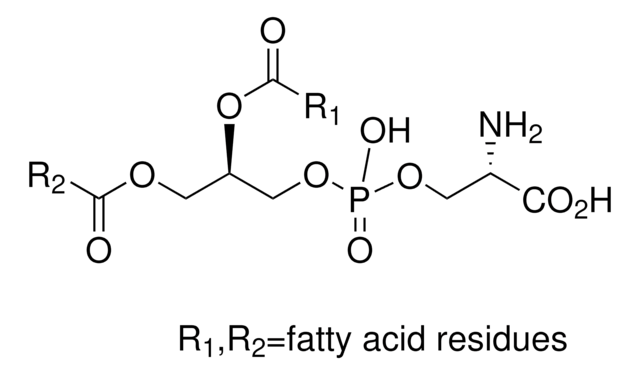840039P
Avanti
18:0-18:1 PS
1-stearoyl-2-oleoyl-sn-glycero-3-phospho-L-serine (sodium salt), powder
Sinónimos:
1-octadecanoyl-2-(9Z-octadecenoyl)-sn-glycero-3-phospho-L-serine (sodium salt); SOPS; PS(18:0/18:1(9Z)); 110672
About This Item
Productos recomendados
Análisis
>99% (TLC)
formulario
powder
envase
pkg of 1 × 10 mg (840039P-10mg)
pkg of 2 × 100 mg (840039P-200mg)
fabricante / nombre comercial
Avanti Research™ - A Croda Brand 840039P
tipo de lípido
phospholipids
cardiolipins
Condiciones de envío
dry ice
temp. de almacenamiento
−20°C
cadena SMILES
[H][C@@](COP([O-])(OC[C@](C([O-])=O)([H])[NH3+])=O)(OC(CCCCCCC/C=C\CCCCCCCC)=O)COC(CCCCCCCCCCCCCCCCC)=O.[Na+]
InChI
1S/C42H80NO10P.Na/c1-3-5-7-9-11-13-15-17-19-21-23-25-27-29-31-33-40(44)50-35-38(36-51-54(48,49)52-37-39(43)42(46)47)53-41(45)34-32-30-28-26-24-22-20-18-16-14-12-10-8-6-4-2;/h18,20,38-39H,3-17,19,21-37,43H2,1-2H3,(H,46,47)(H,48,49);/q;+1/p-1/b20-18-;/t38-,39+;/m1./s1
Clave InChI
ALPKKMIPHGSQRX-NJZWBUMZSA-M
Descripción general
Aplicación
- has been used in the preparation of multilamellar and unilamellar liposomes
- may be used in the preparation of liposomes for liposome binding assays
- may be used to generate multilamellar phospholipid vesicles
Acciones bioquímicas o fisiológicas
Envase
Información legal
también adquirido normalmente con este producto
Código de clase de almacenamiento
11 - Combustible Solids
Certificados de análisis (COA)
Busque Certificados de análisis (COA) introduciendo el número de lote del producto. Los números de lote se encuentran en la etiqueta del producto después de las palabras «Lot» o «Batch»
¿Ya tiene este producto?
Encuentre la documentación para los productos que ha comprado recientemente en la Biblioteca de documentos.
Nuestro equipo de científicos tiene experiencia en todas las áreas de investigación: Ciencias de la vida, Ciencia de los materiales, Síntesis química, Cromatografía, Analítica y muchas otras.
Póngase en contacto con el Servicio técnico





